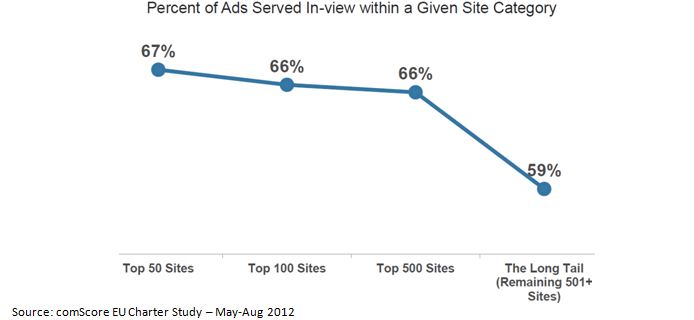Direct-response advertisers should take heed to the current discussions surrounding digital ad viewability: it’s not just about branding. Where demand leads, solutions will follow, so it’s time for advertisers to listen up and understand what viewability means for their budgets this year.
According to the Interactive Advertising Bureau (IAB) and the Media Rating Council (MRC), viewability doesn’t have to do with an ad appearing above or below the fold, but is currently defined as fifty percent of an ad’s pixels in view for one or more seconds. There is testing and reconsideration for larger units, such as the increasingly popular Rising Stars and behaviors such as clicks, but one thing is certain: regardless of how things pan out, the need to distinguish between served and viewable is finally being addressed.
So, why should direct-response advertisers care? Shouldn’t they just prioritize click-based conversions and call it a day? You knew those view-based conversions were a joke anyway, right? Not so fast! Studies by comScore, like this one, have shown that being seen matters more than being clicked. The catch is that being seen does not equal an impression. So, advertisers are right in questioning view-based conversions, but only those that are derived from impressions that were not seen.
What does this mean for your digital ad buy, and your results? How will you explain an increase in cost-per-conversion or return-on-ad-spend to your boss when you take a deeper dive into your media buys and decide it’s time to consider quality? The reality is that prioritizing viewable impressions and legitimate view-based conversions may not look as well on paper, but you should feel confident in assuring your boss their budget is being more wisely spent. Here’s how:
- Demonstrate what you could really be paying to reach your target audience, based on the number of impressions that are validated out of those served. This is not readily available information; however, you might consider using a 3rd party verification tool to get a read on it, such as Adometry’s Validate, DoubleVerify’s ViewAssureor DFA Analytics (coming in 2013). Consider reallocating dollars to placements that have a lower viewable CPM:

- Explore, test, and hopefully prove the effectiveness of media buys priced on a cost-per-viewable-impression rather than a traditional CPM (cost-per-impression).
- Reconsider premium inventory as part of your strategy. Because premium inventory is generally served in-view more often, the rates may be economically viable if calculated against in-view rates:

- Begin to reduce credit you are awarding your media partners for view-based conversions that are based simply on a page pixel load, not a view. Demand that your media partners are optimizing to these conversions rather than all conversions, but only if you can help provide this data to them through one of the solutions mentioned above.
- Consider a lift study to compare how an in-view ad increases conversion across a test and control group. This can help make the case for purchasing quality over low rates, as well as solidify your brand’s post-view attribution strategy. Many media partners will absorb the cost of this study with media investment.
- If your boss is still stuck on click-based conversions, consider this: A study by MediaMindshowed a 54.5% lift in click-through rate for ads that were actually viewable. This example is regarding rich media in particular, but you get the idea:

Viewability is not yet fully solved and the industry is at the brink of understanding its importance, but there is no doubt that direct-response advertisers are affected by a need for better quality. How is viewability understood at your company or agency, and what is still misunderstood?

